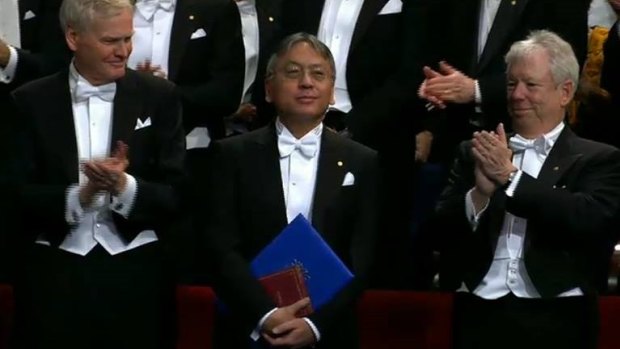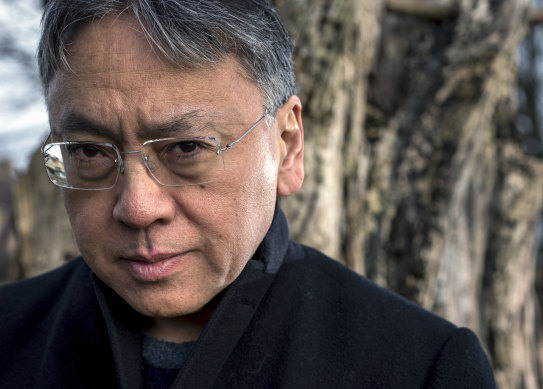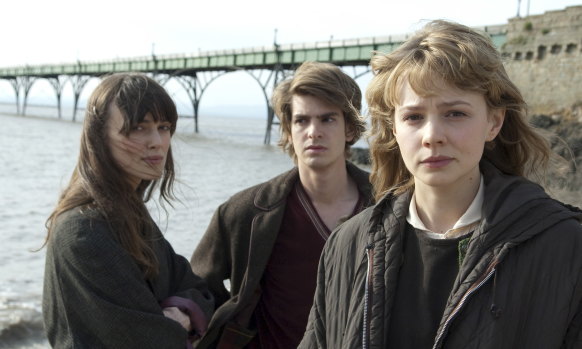This was published 3 years ago
From guitar in a share house to the Nobel Prize: catching up with Kazuo Ishiguro
By Jason Steger
The last time I encountered Kazuo Ishiguro he had a straggle of lank hair and was enthusing about Bob Dylan. To be honest, that’s the only time we’ve met and it was a long time ago, but I have never forgotten him.
We were students at the University of Kent in the cathedral city of Canterbury and were in the share house of a mutual friend who was a generous – and by our standards, good – cook. OK, it was probably bolognaise and garlic bread, but we weren’t complaining. Why would you?

Kazuo Ishiguro playing guitar in the British summer of 1977 in Broad Oak, Kent. Credit: Courtesy Kazuo Ishiguro
Ishiguro brought his guitar and played a bit. He wasn’t hindered by anything as formal as a dining table and, anyway, his ambition was to be a singer-songwriter. He had shown early singing promise, being heralded as the first Japanese boy to become head chorister at his church in Guildford.
But things change. Fast forward to December 2017 and there’s Ishiguro, the picture of elegance in tails and white tie, accepting his Nobel Prize for literature from the King of Sweden. This was the year after Dylan won the Nobel, a link that delights him: “Without Dylan, I would possibly have not become a writer at all.”
Ishiguro, who was born in Nagasaki and spent the first five years of his life in Japan before his parents moved to England, is the author of seven novels and a volume of short stories. He is best known for The Remains of the Day, for which he won the Booker Prize, about Stevens the butler at an English stately home in the fraught years before World War II and his gradual realisation that he has let important moments in his life slip by, and Never Let Me Go, the story of cloned children created for the purposes of organ donation.
Next month, his latest novel, Klara and the Sun, will appear. He was about a third of the way through when he won the Nobel and, worryingly at the time, had to put it aside. In reality it turned into “one of those half-time breaks that was useful”.

Kazuo Ishiguro receives his Nobel in 2017.Credit: Getty Images
Today we encounter each other over a Zoom call. It’s a chilly morning in north London and Ishiguro is upstairs in his house, neat and tidy in a black T-shirt. He is unfailingly polite and happy to talk. Of course there is reminiscing: he recalls his obsession with writing songs and performing them at the university and the Duke of Cumberland in the nearby town of Whitstable. (Some of his friends formed Fiddler’s Dram, who had a top-10 hit in Australia with Day Trip to Bangor.)
Songwriting was his apprenticeship to fiction. It was in the folk clubs that he traversed the “purple phase” he says young writers go through and by the end of “my little songwriting career” – he laughs without any apparent regret – he had pared things down so “everything’s by implication, everything’s below the surface. As far as the lyrics are concerned, it’s all between the lines.”
(With a group of Kent friends he recorded the now-elusive “Broad Oak Tapes” in a tiny village near Canterbury. The recordings exist - somewhere; he’s not sure where - but when he sold his archives to the Harry Ransom Center in Texas, he was relieved they were analogue and could be neatly excluded from the deal.)
That method made the transition to short stories – his first fictions – natural and it’s an approach he has never outgrown. “In my head I’m standing up at the folk club with 20 people I’m singing to and I’ve got to somehow communicate with them. And it seems the voice I come out with in my books is still a bit like a voice that would be appropriate to that situation – first-person, quite intimate, not noisy. It’s a folk club so don’t pretend you’re in a stadium. That idea of keeping meaning slightly below the surface, as you have to do in the song form, that’s remained with me.”

Kazuo Ishiguro says his new novel is “an examination of love and what does it mean to love”.Credit: NYT
His new novel emerged partly from an interest in artificial intelligence and gene-editing techniques. Klara is an “Artificial Friend” waiting in a display window to be snapped up by a family to live with their child. As she waits she observes life outside, learning how humans operate, but becomes “puzzled, then increasingly fascinated by the more mysterious emotions passers-by would display in front of us. I realised that if I didn’t understand at least some of these mysterious things, then when the time came, I’d never be able to help my child as well as I should.”
Klara – gamine and preternaturally curious – relishes the nourishing powers of the sun. When Josie comes into the shop there is an immediate connection between them and eventually Josie’s mother buys Klara. Josie, it turns out, has undergone a risky gene-editing process that has “lifted her” into a sort of elite rank of children, but also damaged her health. Klara is puzzled that the sun hasn’t helped Josie; she decides that “for her to receive the Sun’s special help, it might be necessary to draw his attention to Josie’s situation in some particular and noticeable way”.
At the core of the novel is a question Josie’s father asks Klara: “Do you believe in the human heart? I don’t mean simply the organ, obviously. I’m speaking in the poetic sense. The human heart. Do you think there is such a thing? Something that makes each of us special and individual?”
Ishiguro says while the society he imagines in Klara and the Sun has a savage meritocracy developing, his concerns as a novelist are closer to things he’s always been interested in, such as memory and love. In this time when big data companies have the ability to “kind of excavate our personalities to the point of being able to say ‘you’re like this, you’ve got to say this, you’ve got to do that’ ... it does raise this question of would this change the way we actually relate to each other”.
So, “the book is an examination of love and what does it mean to love, what does it mean to be a human being,” he says. “I’m not banging on about the dangers or breakthroughs in science, but that forms a necessary backdrop because without that these questions aren’t there. But I think these questions are here already. It’s a modern way of looking at questions that people did in the 19th century.”
In some respects, Klara and the Sun can be seen as a response to the sadness in Never Let Me Go, his 2005 novel about the inevitability of mortality. He wanted to show that despite everything there are good things in the world and good things about human nature.
At one point, Klara wonders whether all humans are lonely. Ishiguro has written a lot about lonely people – think of Etsuko, the isolated Japanese mother living in Britain in A Pale View of Hills, Sir Gawain in The Buried Giant, Stevens in The Remains of the Day, or Christopher Banks in When We Were Orphans, even Ryder in The Unconsoled.
It’s not everyday loneliness, he points out; he’s trying to express the idea that human beings are fundamentally lonely and it takes a great deal to bridge that state.
“One of things about writing fiction – and maybe that’s why I always wanted to be a solo singer-songwriter – is there’s something about that artform which seems to accentuate that. Certainly a first-person narration starts to map out thoroughly the interior world of just one individual and you start to see how impenetrable it is for other people. You realise there’s this massive world inside people and even if people live together, or love very closely ... each individual is going to have one of these massively complex things that applies only to them.”
I haven’t got time to spend months thinking about one character and how they feel, but the actors do and they’re bound to do better than me.
When the Ishiguro family moved to England, they expected to return to Japan. They were, Ishiguro said in his Nobel address, in a “perpetual state of going back ‘next year’”. He has dedicated Klara and the Sun to his mother, Shizuko, who died while he was writing it. She was a profound influence.
“She introduced me to a lot of books. She was very well read in Western literature that she’d read in Japanese. Also when I was younger, she had a great gift for telling stories as a kind of one-person show. So a lot of Shakespeare plays I knew the storylines of because my mother had acted them out. There are still plays like The Merchant of Venice that I’ve never seen, but if someone talks about the characters, I just see my mother’s performance and I remember the characters’ names in Japanese pronunciation.”
As his first two books – A Pale View of Hills and An Artist of the Floating World – are set partly in wartime Japan, he mined his mother’s memories to create his version of the country. His father, Shizuo, an oceanographer, never discussed the war.
“She would talk about her friends and if the experiences involved bombings or fires in factories or people dying, that’s what I heard. I had a kind of civilian’s viewpoint of a woman in her late teens in Nagasaki, that was my vision of the Second World War. Then the American occupation and how scared they were before the Americans arrived and how she and her sister went to hide up in the mountains ... and the relief when the Americans turned out to be so benevolent.”

From left, Keira Knightly, Andrew Garfield and Carey Mulligan in Never Let Me Go.
Although Ishiguro has written screenplays, he didn’t do so for the adaptations of The Remains of the Day and Never Let Me Go. Rights to Klara and the Sun have been bought by David Heyman, producer of the Harry Potter films. Curiously, Ishiguro says in the films of his books, he has learnt more about the characters he created. There’s a scene in Never Let Me Go when two main characters, Kathy and Tommy, get some crucial information. The way Carey Mulligan as Kathy receives it, with a sort of stoicism, came as a surprise to Ishiguro.
“I often understand things about characters I have written because of how the actor brings something to it,” he says. “I haven’t got time to spend months thinking about one character and how they feel, but the actors do and they’re bound to do better than me. I think there is this phenomenon when I start to think I don’t really own these characters ... I have set something going and other people can go off and make them more substantial or take them in slightly different directions.”
He too has taken his work in different directions. Despite declaring his songwriting over, he writes lyrics for jazz singer Stacey Kent. On her Grammy-nominated album Breakfast on the Morning Tram, the title track, one of four he wrote the lyrics for, is a reworking of the end of The Unconsoled. (Rather sweetly, Kent chose the next track to be the Ray Evans and Jay Livingston song, Never Let Me Go.)
When he began writing for Kent 12 years ago she said she knew he wrote sad things but wanted love songs with a little hope.
“That was a kind of revelation to me. When my own writing has worked well there has always been a tiny bit of hope as well. In Klara, there’s quite a lot of hope, and it’s important when you’re using a sad landscape, when the essential vision is bleak, it’s important to have hope and sunlight there. Partly because that reflects who I am, but also to make the thing work as a piece of art.”
But Klara is not the only work of art he has hope for. Two weeks after it comes out, Common Ground, the first novel by his daughter, Naomi, will be published.
“I’m terribly excited. I kept suggesting that we did joint publicity, but she turned most of it down. She’s happy to be my daughter up to a point but she doesn’t want people to think this is a novel by Ishiguro’s daughter.”
And another hope? Perhaps to meet his predecessor in the Nobel ranks.
Klara and the Sun is published by Faber & Faber on March 2 at $32.99.